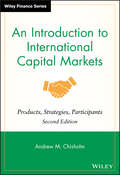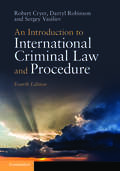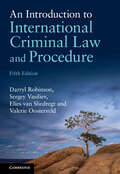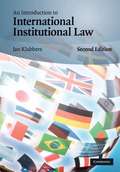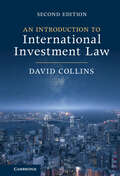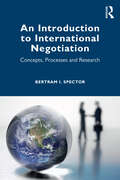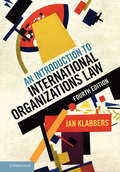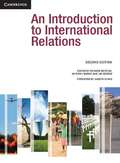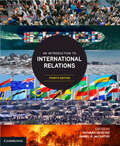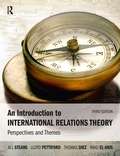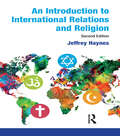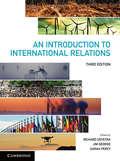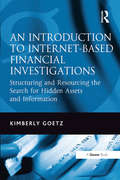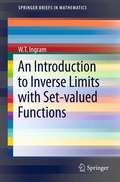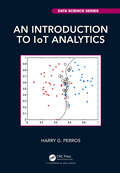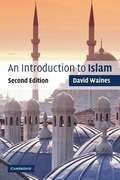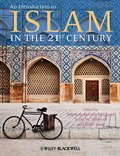- Table View
- List View
An Introduction to International Arbitration
by Ilias BantekasThis concise yet comprehensive textbook introduces the reader to the law and practice of international arbitration. Arbitration is a complex field due to the variety of disciplines involved and necessitates an approach that takes nothing for granted. Written by a renowned scholar and practitioner, this book explains the divergent issues of civil procedure, contracts, conflict of laws, international law amongst others in an accessible manner. Focusing mainly on international commercial arbitration, the book also features a distinct chapter on consumer and online arbitration and an equally comprehensive chapter on international investment arbitration.
An Introduction to International Capital Markets
by Andrew M. ChisholmFully revised and updated from the hugely popular first edition, this book is an accessible and convenient one-volume introduction to international capital markets, ideal for those entering or planning to enter investment banking or asset management. As well as serving as an invaluable reference tool for professionals already working in the industry looking to extend their knowledge base it will also benefit all those working in trading, sales and support roles.Describing how the key products and markets work, who the principle participants are and their overall goals and objectives, Andrew Chisholm provides a thorough overview of the global capital markets. The book covers a wide range of equity, debt, foreign exchange and credit instruments as well as the principal derivative products. In a step-by-step fashion, making extensive use of real world cases and examples, it explains money markets, foreign exchange, bond markets, cash equity markets, equity valuation techniques, swaps, forwards, futures, credit derivatives, options, option risk management and convertible bonds. An extensive glossary also explains concisely many of the 'jargon' expressions used in the financial markets.Boasting an international focus, examples are drawn from major international markets around the world. It makes extensive use of numerical examples and case studies to help explain a wide range of cash and derivative products used in the capital markets business. It covers both debt and equity products and includes new material on credit products such as collateralized debt obligations and credit derivative structures; equity fundamental analysis, portfolio theory and convertible bonds. Market data has been fully updated from the first edition and recent events such as the 'credit crisis' are discussed.
An Introduction to International Criminal Law and Procedure
by Robert Cryer Håkan Friman Darryl Robinson Elizabeth Wilmshurst Robert Cryer Håkan Friman Darryl RobinsonThis market-leading textbook gives an authoritative account of international criminal law, and focuses on what the student needs to know - the crimes that are dealt with by international courts and tribunals as well as the procedures that police the investigation and prosecution of those crimes. The reader is guided through controversies with an accessible, yet sophisticated approach by the author team of four international lawyers, with experience both of teaching the subject, and as negotiators at the foundation of the International Criminal Court and the Rome conference. It is an invaluable introduction for all students of international criminal law and international relations, and now covers developments in the ICC, victims' rights, and alternatives to international criminal justice, as well as including extended coverage of terrorism. Short, well chosen excerpts allow students to familiarise themselves with primary material from a wide range of sources. An extensive package of online resources is also available.
An Introduction to International Criminal Law and Procedure
by Robert Cryer Håkan Friman Darryl Robinson Elizabeth Wilmshurst Robert Cryer Håkan Friman Darryl RobinsonThis market-leading textbook gives an authoritative account of international criminal law, and focuses on what the student needs to know - the crimes that are dealt with by international courts and tribunals as well as the procedures that police the investigation and prosecution of those crimes. The reader is guided through controversies with an accessible, yet sophisticated approach by the author team of four international lawyers, with experience both of teaching the subject, and as negotiators at the foundation of the International Criminal Court and the Rome conference. It is an invaluable introduction for all students of international criminal law and international relations, and now covers developments in the ICC, victims' rights, and alternatives to international criminal justice, as well as including extended coverage of terrorism. Short, well chosen excerpts allow students to familiarise themselves with primary material from a wide range of sources. An extensive package of online resources is also available.
An Introduction to International Criminal Law and Procedure
by Robert Cryer Darryl Robinson Sergey VasilievWritten by a team of international lawyers with extensive academic and practical experience of international criminal law, the fourth edition of this leading textbook offers readers comprehensive coverage and a high level of academic rigour while maintaining its signature accessible and engaging style. Introducing the readers to the fundamental concepts of international criminal law, as well as the domestic and international institutions that enforce that law, this book engages with critical questions, political and moral challenges, and alternatives to international justice. Suitable for undergraduate and postgraduate students, academics and practitioners in the field, and cited by the International Criminal Tribunal for Yugoslavia, the International Criminal Court, the Special Court for Sierra Leone, the Extraordinary Chambers in the Courts of Cambodia, and the highest courts in domestic systems, this book is a must-read for anyone interested in learning more about international criminal law.
An Introduction to International Criminal Law and Procedure
by Darryl Robinson Sergey Vasiliev Valerie Oosterveld Elies van SliedregtBuilding on the success of previous editions (Cryer et al.), this popular textbook is now expanded and updated in a 5th edition featuring two new co-authors, Elies van Sliedregt and Valerie Oosterveld. A market leader and one of the most globally trusted textbooks on international criminal law, it is known for its accessible and engaging tone and for an even-handed approach that is both critical and constructive. Comprehensively updated and rewritten, this new edition introduces readers to the main concepts of international criminal law, as well as the domestic and international institutions that enforce it, and addresses the latest challenges and controversies surrounding the International Criminal Court. Written by a team of international criminal lawyers who have extensive academic and practical experience in the field, the book engages with critical questions, political and moral challenges, and alternatives to international justice. It contains helpful references to other literature, making it a valuable research resource.
An Introduction to International Economics
by Kenneth A. ReinertThis book is designed for a one-semester or two-semester course in international economics, primarily targeting non-economics majors and programs in business, international relations, public policy and development studies. It has been written to make international economics accessible to wide student and professional audiences. The book assumes a minimal background in microeconomics and mathematics and goes beyond the usual trade-finance dichotomy to give equal treatment to four 'windows' on the world economy: international trade, international production, international finance and international development. It takes a practitioner point of view rather than a standard academic view, introducing the student to the material they need to become effective analysts in international economic policy. The website for the text is found at http://iie.gmu.edu.
An Introduction to International Institutional Law
by Jan KlabbersInternational institutions are powerful players on the world stage, and every student of international law requires a clear understanding of the forces that shape them. For example, with increasing global influence comes the need for internal control and accountability. This thought-provoking overview considers these and other forces that govern international institutions such as the UN, EU and WTO, and the complex relationship that exists between international organizations and their member states. Covering recent scholarly developments, such as the rise of constitutionalism and global administrative law, and analysing the impact of important cases, such as the ICJ's Genocide case (2007) and the Behrami judgment of the European Court of Human Rights (2007), its clarity of explanation and analytical approach allow students to understand and think critically about a complex subject.
An Introduction to International Investment Law
by David CollinsThis insightful and accessible introduction provides students and practitioners with a comprehensive overview of the increasingly important discipline of international investment law. Focusing primarily on the legal principles contained in the growing body of international investment agreements, this book covers the core concepts of the discipline with attention given to their relation to each other and to the manner in which they have been developed through arbitration case law. The context of each legal principle is explored along with a consideration of some of the major debates and emerging criticisms. Avoiding extensive case extracts, this book adopts an engaging and succinct narrative style which allows readers to advance their understanding of the topic while examining the legal principles with academic rigour and discerning commentary.
An Introduction to International Investment Law
by David CollinsThis insightful and accessible introduction provides students and practitioners with a comprehensive overview of the increasingly important discipline of international investment law. Focusing primarily on the legal principles contained in the growing body of international investment agreements, this book covers the core concepts of the discipline, with attention given to their relation to each other and to the manner which they have developed through arbitration case law. The context of each legal principle is explored, along with a consideration of some of the major debates and emerging criticisms. Avoiding extensive case extracts, this book adopts an engaging and succinct narrative style which allows readers to advance their understanding of the topic while examining the legal principles with academic rigour and discerning commentary.
An Introduction to International Negotiation: Concepts, Processes and Research
by Bertram I. SpectorThis textbook provides a comprehensive introduction to the international negotiation system – its key elements and processes, what major issues and challenges it faces, and its impacts on international relations. As a major catalyst of global dynamics, negotiation is used to resolve conflicts and promote cooperation peacefully. It is important to understand how it works. First, the book analyzes the principal factors that interact to move the negotiation system forward – the issues and context, actors, structures, strategies, and outcomes. Then, the discussion considers the four basic subprocesses of international negotiation – getting to the table, conducting negotiations, developing implementation plans, and continuing negotiations in the post-agreement period. Relevant research is presented in each chapter to elaborate on these dynamics and offer case studies of negotiations addressing intrastate conflict, the environment, terrorism, anti-corruption and good governance, and post-agreement issues. In addition, the book examines major conflictual conundrums currently facing the world in the Middle East and Ukraine to explore opportunities for negotiated solutions. Providing a solid mix of theory, research, and real-world cases that offers readers a comprehensive appreciation of the field and how it is used on a practical level, this is an excellent basic text for courses on international relations, peace studies, conflict resolution, and international negotiations, and a useful resource for researchers, policymakers, and practitioners.
An Introduction to International Organizations Law
by Jan KlabbersThe third edition of this market-leading textbook (previously called An Introduction to International Institutional Law) is written in a clear, three-part structure. It is centred on the dynamics of the relationships between international organisations and their organs, staff, and the outside world. It discusses the essential topics of the law of international organisations, including powers, finances, and privileges and immunities, as well as membership rules, institutional structures, and accountability. The newly revised text has been updated extensively to reflect the entry into force of the EU's Lisbon Treaty (and Croatia's accession) and new articles on the responsibility of international organisations. The chapters have also been reorganised for further clarity. Two new chapters, on the international civil service and the relations between organisations and other institutions, respectively, have been added.
An Introduction to International Organizations Law
by Jan KlabbersThe fourth edition of this market-leading textbook offers students a clear framework for understanding the practice and logic of International Organizations Law. It is structured around the three defining relationships IOs engage in – namely, with their member states, with their organs and staff, and with the outside world. These different dynamics give rise to different concerns, which each help to explain the logic behind international institutional law. The text also discusses the essential topics of the law of IOs, including powers and finances, privileges and immunities, institutional structures, and accountability. By demonstrating how the theory works in practice, with recent examples, students will observe the impact and significance of International Organizations Law. Updated with the latest case law and literature, this new edition also contains discussions of the withdrawal of Israel and the US from UNESCO, Brexit, and the Covid-19 pandemic, and how these affect the law of international organizations.
An Introduction to International Relations
by Richard Devetak Jim George Anthony BurkeInvaluable to students and those approaching the subject for the first time, An Introduction to International Relations, Second Edition provides a comprehensive and stimulating introduction to international relations, its traditions and its changing nature in an era of globalisation. Thoroughly revised and updated, it features chapters written by a range of experts from around the world. It presents a global perspective on the theories, history, developments and debates that shape this dynamic discipline and contemporary world politics. Now in full-colour and accompanied by a password-protected companion website featuring additional chapters and case studies, this is the indispensable guide to the study of international relations.
An Introduction to International Relations
by Richard Devetak Daniel R. McCarthyInternational Relations is a dynamic discipline, evolving in response to contemporary world politics. An Introduction to International Relations offers a foundational explanation of the theories, systems, actors and events that shape external relations between nations in today's global society. This edition retains the existing structure, grouping chapters on theories, international history and the 'traditional' and 'new' agendas, while acknowledging that these exist alongside one another and intersect in complex ways. The text has been comprehensively updated and includes new chapters on postcolonialism, the international politics of cyberspace, global public health and the futures of International Relations. New postcard boxes and case studies present contemporary examples of international relations in action, and discussion questions at the end of every chapter promote student engagement. Written by an author team of leading academics from Australia, New Zealand and around the world, An Introduction to International Relations remains a fundamental guide for students of international relations.
An Introduction to International Relations Theory: Perspectives and Themes
by Thomas Diez Jill Steans Imad El-Anis Lloyd PettifordThis long-awaited new edition has been fully updated and revised by the original authors as well as two new members of the author team. Based on many years of active research and teaching it takes the discipline's most difficult aspects and makes them accessible and interesting. Each chapter builds up an understanding of the different ways of looking at the world. The clarity of presentation allows students to rapidly develop a theoretical framework and to apply this knowledge widely as a way of understanding both more advanced theoretical texts and events in world politics.Suitable for first and second year undergraduates studying international relations and international relations theory.
An Introduction to International Relations and Religion
by Jeffrey HaynesNot so very long ago it seemed reasonable to assert that the influence of religion on global politics was on the wane. As the Western world became increasingly secular and the process of globalisation deepened, it seemed inevitable - on the surface at least - that the voice of religion was to be heard softly if it was to be heard at all. This has now changed, and changed perhaps irrevocably. As Jeff Haynes argues in this thought-provoking and important new book, various religious 'actors' are now significantly involved in international relations and have become a crucial influence on policy in a post-Westphalian world. International Relations and Religion guides the reader through the complex issues at the heart of this topic with clarity and insight. This updated second edition starts with a close reading of the many theoretical and analytical concepts - notably Huntington and the clash of civilisations - that have grown up around this area and then concludes with a summary of the issues under discussion and attempts to put into context what it means to live in a world that is increasingly shaped by a whole host of diverse religious groups. Essential reading for students of International Relations and Politics.
An Introduction to International Relations: Australian Perspectives (Critical Perspectives On World Politics Ser.)
by Richard Devetak Jim George Sarah PercyAn Introduction to International Relations is a comprehensive introduction to the history, theories, developments and debates that shape the dynamic discipline of international relations and contemporary world politics. Bringing together an expert author team comprising leading academics from Australia and around the world, it allows readers to explore the discipline from both Australian and global perspectives. Known for its clear, easy-to-read style and relevant, real-world examples, the text has been fully updated and revised to reflect current research and the changing global political climate. This edition features extensive new material on: international history from World War I to World War II; international law; the globalisation of international society; and terrorism. A companion website for instructors offers additional case studies, critical thinking questions and links to relevant video and web materials that bring international relations theory to life.
An Introduction to Internet-Based Financial Investigations: Structuring and Resourcing the Search for Hidden Assets and Information
by Kimberly GoetzIncreasingly, employees of regulatory bodies, law enforcement agencies and others who are not trained forensic accountants or experienced investigators find themselves responsible for conducting what amount to financial investigations. An engineer who oversees the cleanup of a toxic waste site might need to track down the former owners of the site to find the polluter. Perhaps the applicable licensing agency receives a complaint that an attorney mishandled a client's money. Maybe it's the attorney who needs help finding the assets with which a client's former spouse has absconded. Training in investigation techniques tends to be very limited for many employees. Training on how to find information without incurring significant expense is virtually nonexistent. This book helps fill the void. An Introduction to Internet-Based Financial Investigations will help anyone who conducts financial investigations as part of their job to reduce their dependence on trial and error by showing them where and how to look. Using clear sections describing how to approach an investigation, including the ethical perspective; what to look for and what you find; what free and low cost internet resources are available to support investigations; and how to assemble and present the results of investigations, Kimberly Goetz guides students and beginning investigators through the complex world of financial investigations.
An Introduction to Inverse Limits with Set-valued Functions (SpringerBriefs in Mathematics)
by W. T. IngramInverse limits with set-valued functions are quickly becoming a popular topic of research due to their potential applications in dynamical systems and economics. This brief provides a concise introduction dedicated specifically to such inverse limits. The theory is presented along with detailed examples which form the distinguishing feature of this work. The major differences between the theory of inverse limits with mappings and the theory with set-valued functions are featured prominently in this book in a positive light. The reader is assumed to have taken a senior level course in analysis and a basic course in topology. Advanced undergraduate and graduate students, and researchers working in this area will find this brief useful.
An Introduction to IoT Analytics (Chapman & Hall/CRC Data Science Series)
by Harry G. PerrosThis book covers techniques that can be used to analyze data from IoT sensors and addresses questions regarding the performance of an IoT system. It strikes a balance between practice and theory so one can learn how to apply these tools in practice with a good understanding of their inner workings. This is an introductory book for readers who have no familiarity with these techniques. The techniques presented in An Introduction to IoT Analytics come from the areas of machine learning, statistics, and operations research. Machine learning techniques are described that can be used to analyze IoT data generated from sensors for clustering, classification, and regression. The statistical techniques described can be used to carry out regression and forecasting of IoT sensor data and dimensionality reduction of data sets. Operations research is concerned with the performance of an IoT system by constructing a model of the system under study and then carrying out a what-if analysis. The book also describes simulation techniques. Key Features IoT analytics is not just machine learning but also involves other tools, such as forecasting and simulation techniques. Many diagrams and examples are given throughout the book to fully explain the material presented. Each chapter concludes with a project designed to help readers better understand the techniques described. The material in this book has been class tested over several semesters. Practice exercises are included with solutions provided online at www.routledge.com/9780367686314 Harry G. Perros is a Professor of Computer Science at North Carolina State University, an Alumni Distinguished Graduate Professor, and an IEEE Fellow. He has published extensively in the area of performance modeling of computer and communication systems.
An Introduction to Islam
by David WainesIslam is a world-wide religion embracing many cultures and nations, comprising today nearly 900 million people. Muslims believe that God (Allah) revealed to the Prophet Muhammad guidance for proper conduct in this world and salvation in the next. These revelations are contained in the Muslims' scripture, the Qur'an. From modest beginnings in Mecca fourteen centuries ago, Islam spread rapidly throughout the Middle East and then into south-east Asia. This book is the story of the Muslims' beliefs and practices as they developed during the formative period. Separate chapters are devoted to a description of the sacred law (the Shar'iah), theology, and mysticism. Attention is given also to the beliefs and practices of the important Shi'ah minority of Muslims. The story comes down to the present day, recounting the period over the last two centuries during which Muslims have been challenged by Western hegemony and have sought to establish a modern sense of identity.
An Introduction to Islam
by Frederick DennyAn Introduction to Islam, Fourth Edition, provides students with a thorough, unified and topical introduction to the global religious community of Islam. In addition, the author's extensive field work, experience, and scholarship combined with his engaging writing style and passion for the subject also sets his text apart. An Introduction to Islam places Islam within a cultural, political, social, and religious context, and examines its connections with Judeo-Christian morals. Its integration of the doctrinal and devotional elements of Islam enables readers to see how Muslims think and live, engendering understanding and breaking down stereotypes. This text also reviews pre-Islamic history, so readers can see how Islam developed historically.
An Introduction to Islam (Second Edition)
by David WainesThis wide-ranging account of the history and theology of one of the world's most dynamic religions tells the story of Islamic beliefs and practices as they developed from the earliest times down to the present day. For this revised and updated Second Edition, David Waines has added a long section tackling head-on the issues arising from Islam's place in the changing world order at the turn of the new millennium. The wars in Bosnia, Afghanistan and Israel, and the terrorist attacks on New York and Washington, have raised global awareness of Islam at a superficial level - but little has been written which considers Islamic political and military extremism in relation to mainstream Muslim history and theology. Coming at the end of a book which has explored the ideas and traditions of Islam in depth, this new section offers thought-provoking reflections on the place of religion in the current conflicts.
An Introduction to Islam in the 21st Century
by Aminah Beverly Mccloud Scott W. Hibbard Laith SaudThis engaging introduction to Islam examines its lived reality, its worldwide presence, and the variety of beliefs and practices encompassed by the religion. The global perspective uniquely captures the diversity of Islam expressed throughout different countries in the present day.A comprehensive, multi-disciplinary, and global introduction to Islam, covering its history as well as current issues, experiences, and challengesIncorporates key new research on Muslims from a variety of countries across Europe, Latin America, Indonesia, and Malaysia Central AsiaDirectly addresses controversial issues, including political violence and 'terrorism', anti-western sentiments, and IslamophobiaExplores different responses from various Islamic communities to globalizing trendsHighlights key patterns within Islamic history that shed light upon the origins and evolution of current movements and thought

